Private First Class Pedro Lamon Rivera
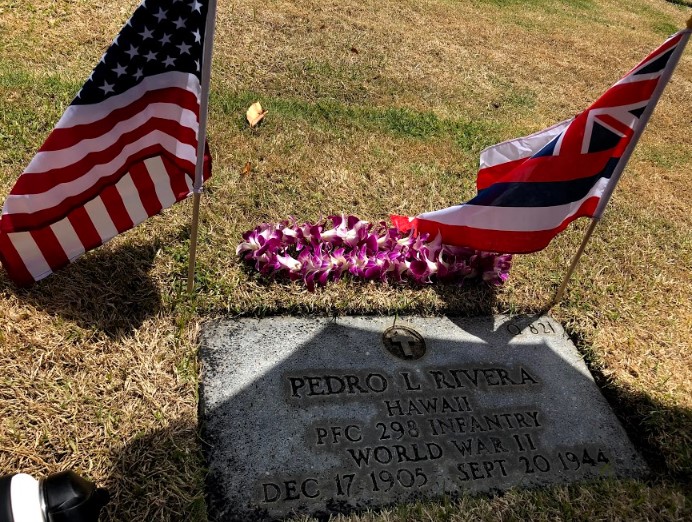
- Unit: 298th Infantry Regiment, Hawai’i National Guard
- Service Number: 30103281
- Date of Birth: December 17, 1905
- Entered the Military: April 9, 1942
- Date of Death: September 20, 1944
- Hometown: Waipahu, Hawaiʻi
- Place of Death: Guadalcanal, Solomon Islands
- Cemetery: Section Q, Grave 821. National Memorial Cemetery of the Pacific, Honolulu, Hawai'i
Mentored by Mrs. Emelda Keola
Waipahu High School
2018-2019
Early Life
Life Before Immigration
On December 17, 1905, Private First Class Pedro Lamon Rivera was born in Ballesteros, Cagayan, Philippines. He had a brother named Domingo. Private Rivera’s formal education in the Philippines was limited to grammar school. His hometown became a part of World War II through the Battle of Bataan.
Following the bombing of Pearl Harbor, Japan attacked the Philippines, prompting American and Filipino soldiers to defend the island against the invasion. The war led many Filipinos to flee in hopes of finding safety and better economic opportunities. Various accounts describe the slaughter and struggle on Private Rivera’s home soil.
A World War II Filipina survivor, Evelyn Betita, said of her experiences that “…the Philippine flag would always fly. But during times of war, it meant safety. When we saw that it was not flying, it meant to hide, to hide in the bamboo plantation.” The Philippines under-trained personnel had no chance of withstanding Japanese imperial attacks. Despite the large number of Filipino and American troops on the island, Bataan fell under Japanese control in April 1942. American and Filipino prisoners of war were forced into the Bataan Death March by their Japanese captors. Those who managed to escape formed guerrilla militant groups who resisted Japanese occupation for the rest of World War II.
A Taste of the “American Life”
Private Rivera immigrated to the United States on February 14, 1942 and was offered a contract at one of the largest construction sites in Hawaiʻi. His employer, Hawaiian Constructors, operated out of Ewa Beach, Hawaiʻi. During the time of Rivera’s employment, the company worked on the construction of the Kahuku Army Air Base. Before Rivera entered the U.S. Army, he resided in a rented room on Peke Lane in Waipahu, Hawaiʻi. His landlord, Gregorio Alvarado, was one of his closest friends. U.S. Army records described Rivera as petite and short, with a dark complexion, a tattoo on his left arm, and a scar on the right side of his face. He lived civilly, with no arrests before enlisting.
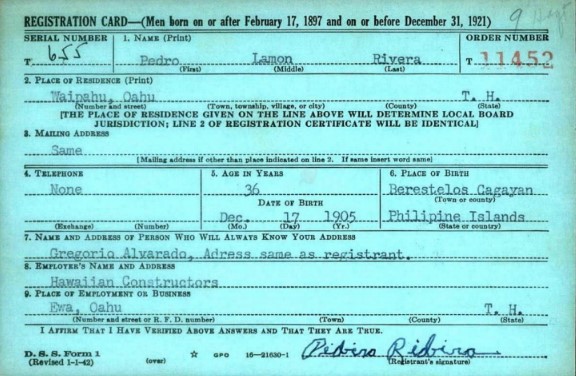
Homefront
A New Found Home
Rivera immigrated to the heart of sugar production. Hawaiʻi was crucial in helping America’s war effort. As World War II began, the U.S. Army and Navy took over, 2,400 acres of Oahu Sugar Company (OSCO) lands for defense. Students from Waipahu High School frequently volunteered and were highly encouraged to recycle scrap rubber and aluminum. In March 1942, units of the U.S. Army moved into a number of school buildings in Waipahu and barracks were erected on the school grounds.
Although communal support was strong, it was not enough to cover large production and construction projects for war. High demands drew Filipino immigrants, known as “sakadas,” to the United States. Sakadas often signed labor contracts with sugar plantations, in exchange for higher wages and financial security. In Waipahu, Filipino immigrants found a high demand for labor at Waipahu Plantation. Waipahu was and still is heavily populated by Filipinos today.
Working Life: Hawaiian Constructors
Hawaiian Constructors played a large role in preparing Hawaiʻi for the war after the bombing of Pearl Harbor. The company came under the control of the U.S. Army Civilian Corps of Engineers in 1941. For 54 consecutive days, Rivera worked as a part of Hawaiian Constructors. They were known for completing large construction jobs for the government during World War II, over $1,000,000 in contracts.
The workload challenged its workers. Employees could get injured or have deductions in payroll for “not working enough.” Hawaiian Constructors continued to do major construction work in Hawaiʻi but transferred smaller jobs to the government. However, mismanagement led to the downfall of the company.
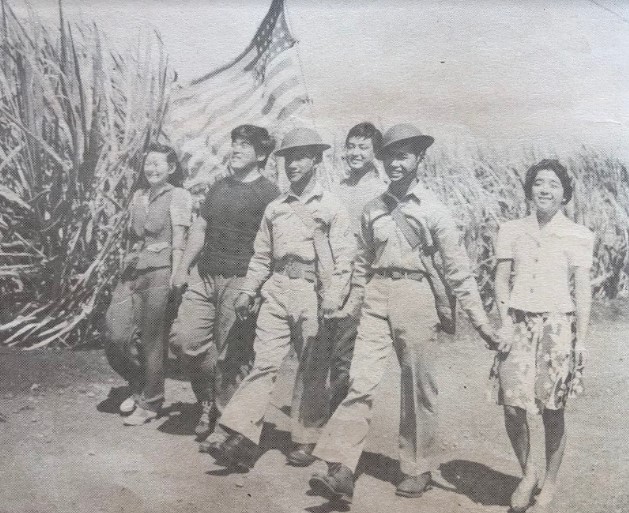

Military Experience
Military Efforts and Sacrifice
Rivera enlisted into the U.S. Army on April 9, 1942. After his enlistment, he was given 13 weeks of basic combat training in Schofield Barracks in Honolulu. He was then stationed with the 298th Infantry Regiment, as part of the Hawaiʻi National Guard. Private Rivera served for two and a half years between April 9, 1942 and September 20, 1944.
Creation of the 298th and 299th Infantry Regiments
There was a high demand for expanding Hawaiʻi’s National Guard after President Franklin D. Roosevelt inducted 250,000 men into the country’s National Guard. General Charles Herron proposed the creation of a multi-ethnic reserve regiment of Nisei Japanese to expand Hawai’i’s Guard. Some soldiers took issue with this proposal, as many white men refused to serve under Nisei officers. Despite that, Herron’s “racially integrated reserve regiment that trained together, gained experience and enjoyed the support of the Army,” after it was formed in 1940 as the 298th and 299th Infantry Regiments.
Later they were combined into the 100th Infantry Battalion. The 100th Infantry Battalion was a segregated unit including American of Hawaiian, Chinese, Puerto Rican, Filipino, Korean, and Japanese descent. While Private Rivera was one of many Filipino men within this division, these specific units were heavily populated with Nisei Japanese ancestry.
Purpose and Mission
The 299th Infantry Regiment constructed military installations on Maui, Molokai, Kauai, and Hawaiʻi Islands. While the 298th Infantry Regiment performed its duties on the island of Oahu. Private Rivera served with the 298th Infantry Regiment.
After Pearl Harbor, all 298th Infantry Regiment members reported for active duty. In the following six months, they performed various jobs around Oahu. They strung barbed wire, patrolled beaches, and built dugouts. The 299th Infantry Regiment soldiers had similar duties on other islands and worked on military installations. In the summer of 1942, 1,406 soldiers from the 298th and 299th Infantry Regiments (including 26 troops from Combat Engineer Battalions), moved to a newly organized battalion that would be designated the 100th Infantry Battalion.
The American Strategy: Leapfrogging
Leapfrogging, or “Island Hopping,” was a strategy used by the United States during World War II in the Pacific Theatre. They took smaller islands and built military bases across the Pacific Ocean. The Commander of the Allied forces in the Southwest Pacific, General Douglas MacArthur, and the Commander-in-Chief of the Pacific fleet, Admiral Chester W. Nimitz led these attacks.
The U.S. troops targeted islands not controlled by the Japanese. On the invaded lands, they constructed landing strips and military bases. Troops then attacked islands with established Japanese bases. As the U.S. moved closer to Japan, they planned the first American landing on Japanese territory.
On April 26, 1942, MacArthur and Admiral William “Bull” Halsey met to create a plan, code named “Cartwheel,” to corner Japanese troops on Rabaul Island. This gave leeway for MacArthur’s troops to advance along the northern coast of New Guinea. Halsey’s troops drove north from Guadalcanal, taking control of the Solomon Islands. The 298th Infantry Regiment took part in this attack. Private Rivera was stationed in Guadalcanal, where he died from a stabbing to the thorax in a non-combat assault. His death has no links to the Battle of Guadalcanal.
The island hopping strategy was very costly but successful. It allowed the U.S. to gain control over sufficient islands in the Pacific Theatre to launch the invasion of Iwo Jima, Japan. However, the U.S. soldiers were not used to guerrilla-style fighting, making combat difficult. Many U.S. soldiers contracted illnesses like malaria, dysentery, and skin fungus.
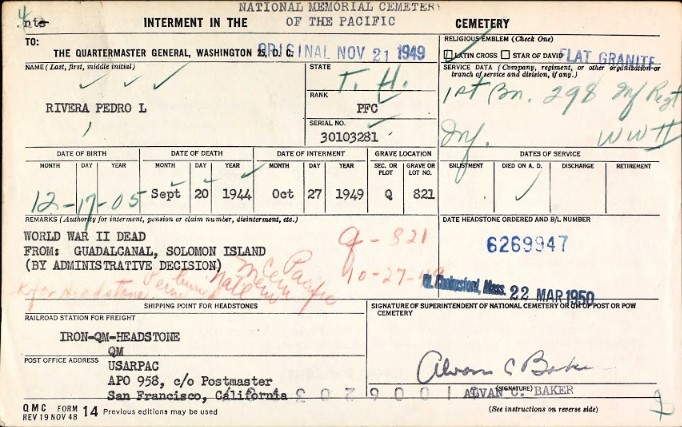
Eulogy
Private First Class Pedro Lamon Rivera,
As red, blue, and yellow hovered over Ballesteros, I can feel the overflowing sense of safety. The insecurity felt in leaving your motherland can never be matched. But the intention you carried in America can never be thanked enough. As you left a month into Bataan’s bloodshed for the “American life,” I see the bright opportunities shining like you must’ve imagined. You are a man inextricably woven into the fabric of America.
In the mists of April 9, 1942, I could only imagine the amount of patriotic bravery it took to put your life in America’s hands. The gallantry in your bones were not only strong enough to stand for a country that did not produce you but to stand for its freedom weighing down on your shoulders. Your service will not only be data to the casual “How many people served in World War II?” Google search, but for the drive within me, revamped by your story.
Buried among men of righteousness and bravery, you lay with your kind. America did not only lose “another soldier,” the Philippines lost a son of heroism, Greogorio lost a dear friend, the 298th infantry Regiment lost a brother, and I lost a mentor. You have not only earned the right to lay in a virtuous grave but my respect.
It’s been a privilege researching your illuminating journey. Your narrative may have not been a common story in history books, but your bravery is forever engraved amongst the definition of sacrifice.
Here we are, seventy-five years later, and your story is still serving a purpose: inspiring a 15-year-old Filipino girl from Waipahu, to not only strive with grit; but to live in fearlessness.
Dios ti kumoyug kennka Private Rivera. Agyamanak.
May this Silent Hero Rest In Peace. Thank you.
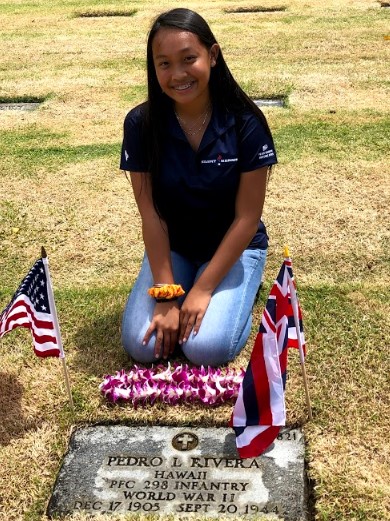
Reflection
When I was first chosen to represent a fallen soldier for the Sacrifice for Freedom®: World War II in the Pacific program, I was hesitant. I was not the most engaged with the topic of World War II or the ideal “history nerd.” But the knowledge and opportunities this program has provided me can never be found anywhere else. I’ve been introduced to interesting yet lovely individuals, learned many differing viewpoints on World War II, laughed my lungs out while playing cards in the hotel lobby, and even got to step foot in America’s only palace! But the most rewarding part of this program was honoring my fallen hero, Private First Class Pedro Lamon Rivera, whom I now consider a special friend.
I chose to represent Rivera as his life story was similar to the sacrifices of my family. By being of Filipino descent from Waipahu, I felt a flame within me light up – I needed to bring his story to the surface. Researching Rivera for the past six months has been hectic and stressful, but I feel as though I’ve gained an understanding of our freedoms. This “forgotten soldier” will forever be remembered. His story will be continued to be shared, not just by me, but hundreds of more students.
Visiting Punchbowl was one of the most monumental feelings. The horizon was filled with infinite rows of other grave markers. I was standing by men of selflessness, women of strength, and individuals of history. Behind the names on each grave marker is a story. The names on these graves are not of ordinary citizens, war statistics, or the “average Joe.” The names on these graves represent bravery, courage, integrity, and the list goes on. These individuals are not only pieces in history but also an enchantment of what all of us strive to have within us: sacrifice. These characteristics not only lie within veterans, but all individuals that have stepped up to work, tolerated the indifference, or even those like you and I that strive to keep their legacies alive.
Filipinos have an old superstition that says if it begins to rain at a grave site, the person you are visiting is waiting for you at their grave. As I stepped up to Private Rivera’s grave marker, the wind began to blow, the sun lingered behind the clouds, umbrellas began to rise, and rain began to shower. He was watching. And he was watching proudly.
Bibliography
Primary Sources:
An Act to Provide for the Common Defense….and provide for its training. September 16, 1940. 76th Congress. www.legisworks.org/congress/76/publaw-783.pdf.
Lee, Lloyd, Ed. In Freedom’s Cause: A Record of the Men of Hawaii who died in the Second World War. Honolulu: University of Hawaii, 1949. Hawaii War Records Depository.
Lodge, R.H. Waipahu at War: The War Record of a Hawaiian Sugar Plantation Company. Waipahu: Oahu Sugar Company, 1945.
Pedro L. Rivera, VA Master Index Card, Hospital Report, and internment card, Department of the Army, RG 319, National Archives and Records Administration – St. Louis.
Pedro L. Rivera. U.S. National Cemetery Interment Control Forms, 1928-1962. Digital Images. ancestry.com.
An Act to Provide for the Common Defense….and provide for its training. September 16, 1940. 76th Congress. www.legisworks.org/congress/76/publaw-783.pdf.
Pedro Lamon Rivera. U.S. WWII Draft Cards Young Men, 1940-1947. Digital Images. ancestry.com.
Pedro L. Rivera. U.S., World War II Army Enlistment Records, 1938-1946. Digital Images. ancestry.com.
Secondary Sources:
Bangui, Oscar. In-person Interview with the author. June 21, 2019.
Bennet, John D. “Kahuku Army Air Base: One of Oahu’s World War II Satellite Fields.” American Aviation Historical Society Journal (Spring 2011): 52-61. hiavps.com/Airfield%20Histories/Kahuku/Bennet%20Kahuku%20History.pdf.
Betita, Evelyn and Josie Bolivar. Women in World War II Interview. YouTube. Updated June 9, 2010. Accessed September 4, 2019. www.youtube.com/watch?time_continue=5&v=cizD8vnM4Mo.
Hirata, Jayne. “The 298th and 299th Story.” 100th Infantry Battalion Veterans Organization. Accessed June 21, 2019. www.100thbattalion.org/history/stories/298th-299th-story-2/.
Ines, Mercedes Alvarado. In-person Interview with the author. June 13, 2019.
Kanekoa, Constance. In-person Interview with the author. June 26, 2019.
Norman, Elizabeth M. and Michael Norman. “Bataan Death March.” Encyclopedia Britannica. Updated April 2, 2019. Accessed June 21, 2019. www.britannica.com/event/Bataan-Death-March#ref1224943.
“Pedro L. Rivera.” National Cemetery Administration Nationwide Gravesite Locator. Accessed September 4, 2019. gravelocator.cem.va.gov/index.html?cemetery=N899.
Thompson, Erwin N., and Daniel Van Zyle. Pacific Ocean Engineers: History of the U.S. Army Corps of Engineers in the Pacific, 1905-1980. Washington, D.C.: Government Printing Office, 1981. books.google.com/.
Schachter, Judith. The Legacies of a Hawaiian Generation: From Territorial Subject to American Citizen. Oahu: Berghahn Books, 2013. books.google.com/.
Yeh, Grace. “WWII Environment in the Philippines.” Routes and Roots: Cultivating Filipino American History on the Central Coast. South County Historical Society. Updated March 2010. Accessed June 21, 2019. sites.google.com/site/centralcoastroutesandroots/roots/filipina-women-arrive/wwii-environment-in-the-philippines.

